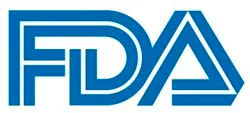FDA Approves Adjuvant Olaparib for BRCA+, High-Risk Early Breast Cancer
The FDA has approved olaparib for the adjuvant treatment of patients with germline BRCA-mutated, HER2-negative, high-risk early breast cancer who have previously received chemotherapy either before or after surgery.
FDA

The FDA has approved olaparib for the adjuvant treatment of patients with germline BRCA-mutated, HER2-negative, high-risk early breast cancer who have previously received chemotherapy either before or after surgery.1
The approval is based on findings from the phase 3 OlympiA trial (NCT02032823), in which olaparib demonstrated a 42% improvement in invasive disease-free survival (iDFS) compared with placebo, which was determined to be statistically significant and clinically meaningful (HR, 0.58; 95% CI, 0.46-0.74; P <.0001).2,3
Moreover, updated data showed that adjuvant olaparib also led to a 32% reduction in the risk of disease progression or death compared with placebo (HR, 0.68; 95% CI, 0.50-0.91; P = .0091). The OS results will be presented at the European Society for Medical Oncology virtual plenary on March 16, 2022.
The safety findings with olaparib were consistent with what has been reported in prior studies of the PARP inhibitor.
“Today’s approval of olaparib is great news for patients with a specific inherited form of breast cancer," Professor Andrew Tutt, global chair of the OlympiA trial and professor of oncology at The Institute of Cancer Research, London and King’s College London, said in a press release.
"Most breast cancers are identified in the early stages and many patients will do very well, but for those with higher risk disease at diagnosis, the risk of cancer returning can be unacceptably high and new treatment options are needed. OlympiA has shown that identifying a BRCA1/2 mutation in women with high risk disease opens the additional option of eligibility for olaparib treatment, which reduces the risk of recurrence and improves survival for these breast cancer patients.”
The multicenter, randomized, placebo-controlled OlympiA trial enrolled 1836 patients withHER2-negative breast cancer harboring a germline BRCA mutation. Patients were randomized 1:1 to receive 300 mg of oral olaparib twice daily for 1 year (n = 921) or placebo (n = 915). Additionally, patients had to have been treated for stage II or III breast cancer, and have completed surgery and chemotherapy, with or without radiotherapy.
Inclusion criteria also required that patients have a high risk of disease recurrence. Those who had received prior treatment with a PARP inhibitor were not eligible for enrollment.
The primary end point for the study was iDFS; secondary end points included distant disease-free survival (DDFS), overall survival (OS), health-related quality of life, and safety.
Additional findings indicated that patients who received olaparib experienced a 43% reduction in DDFS, including metastatic disease, new cancer, and death due to any cause (stratified HR, 0.57; 99.5% CI, 0.39-0.83; P < .0001). The difference in the 3-year DDFS rate between olaparib and placebo was 7.1% (87.5% vs 80.4%, respectively; 95% CI, 3.0%-11.1%).
At the time of the interim analysis, OS data were immature. Although fewer deaths were reported in patients who received olaparib vs placebo, OS was not significantly different between the 2 study arms (stratified HR, 0.68; 99% CI, 0.44-1.05; P = .024). The difference in the 3-year OS rate between the olaparib and placebo arms was 3.7% (92.0% vs 88.3%, respectively; 95% CI, 0.3%-7.1%).
Regarding the safety profile, the adverse effects (AEs) reported in the olaparib arm were consistent with what has been previously reported with the agent. Additionally, olaparib did not increase serious AEs, including hospital admissions or occurrences of other cancers, such as leukemia.
However, grade 3 or higher AEs were reported more often in patients who received olaparib, and included anemia (9%), neutropenia (5%), leukopenia (3%), and fatigue (2%).
The most common AEs of any-grade reported in patients who received olaparib included nausea (57%), fatigue (40%), anemia (23%), vomiting (23%), and headache (20%). The most common AEs of any-grade reported in the placebo arm were fatigue (27%), nausea (23%), headache (17%), diarrhea (14%), and arthralgia (12%).
References
- Lynparza approved in the US as adjuvant treatment for patients with germline BRCA-mutated HER2-negative high-risk early breast cancer. AstraZeneca. News release. March 11, 2022. Accessed March 11, 2022. https://bit.ly/3tQePcn
- Tutt ANJ, Garber JE, Kaufman B, et al. Adjuvant olaparib for patients with BRCA1- or BRCA2-mutated breast cancer. N Engl J Med. 2021;384(25):2394-2405. doi:10.1056/NEJMoa2105215
- Tutt A, Garber JE, Kaufman B, et al. OlympiA: a phase III, multicenter, randomized, placebo-controlled trial of adjuvant olaparib after (neo)adjuvant chemotherapy in patients with germline BRCA1/2 mutations and high-risk HER2-negative early breast cancer. J Clin Oncol. 2021;39(suppl 15):LBA1. doi:10.1200/JCO.2021.39.15_suppl.LBA1



